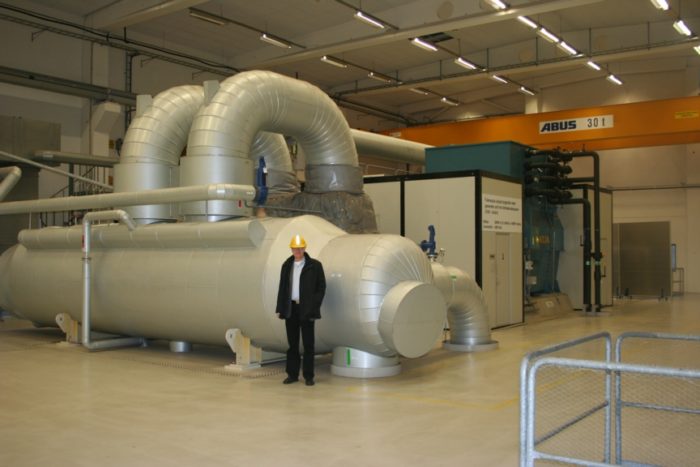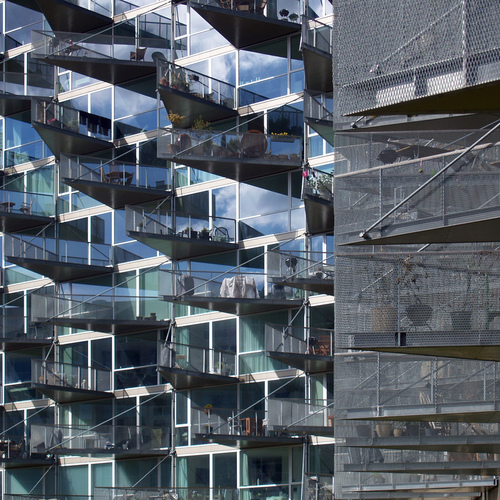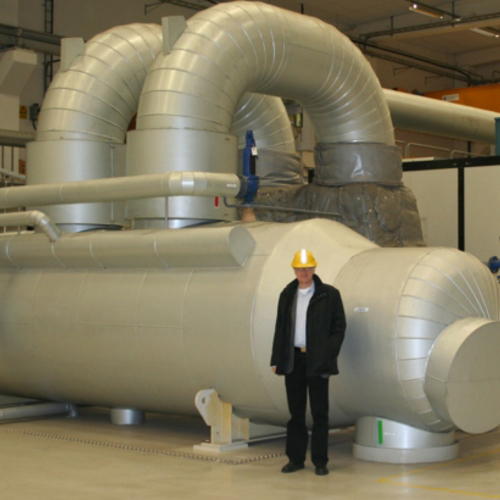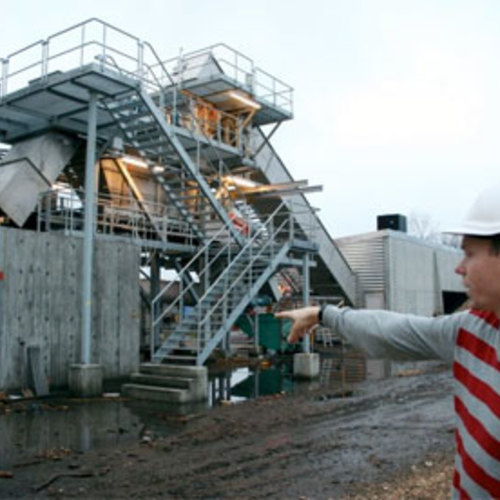
Image Credit: Alex Wilson
Last week I described some observations about transportation from a trip I took to Sweden two years ago. While there, I toured two state-of-the-art, wood-chip-fired, combined heat and power (CHP) plants, one in Kristianstad and one in Växjö.
CHP plants generate electricity, but instead of dumping the waste heat from that power generation process into a nearby river or the air, as we typically do in the U.S., that waste heat is captured and distributed through a network of buried, insulated pipes to heat buildings and deliver process heat to industry. Capturing this waste heat is pretty significant, because it typically represents about two-thirds of the total source energy. In other words, in a conventional power plant in the U.S., only one-third of the fuel-energy going into the plant is converted into electricity; two-thirds is thrown away (usually heating up our rivers in the process).
Relative to the fuel for these CHP plants, it’s important to note that Sweden is a very different place than the U.S. (and Vermont), though the climate and forested landscape in much of Sweden is not too unlike what we have here in Vermont. Two huge cultural differences are the acceptance in Sweden of the reality of climate change and a tax structure that’s helping to move the country away from fossil fuels.
For example, if coal is burned in a power plant in Sweden, the utility company pays more in carbon and sulfur taxes, and for emission permits, than they pay for the actual coal—over 60% of the cost is for these taxes and emission permits. If heavy oil is burned in a power plant, the carbon and sulfur emissions are lower than with coal, and so the taxes and emissions permits account for “only” about 25% of the fuel cost.
What this means is that companies work pretty hard to find energy sources other than fossil fuels. The two plants I visited burn wood chips; Sweden is heavily forested, like Vermont, so these are plentiful. In some places, municipal solid waste is a significant source of energy. In the city of Malmö, the district heating system harnesses geothermal energy and supplements it (about 15%) with solar thermal energy.
In Sweden and most of Scandinavia, CHP plants are “thermal leading.” That is, the plants are operated to satisfy heating needs, and the electricity generated fluctuates according to the heating demand. In the summer months, when there is lower demand for thermal energy, the plants don’t operate as much.
The CHP plants I visited are large. In Kristianstad, the plant burns 18-20 tractor-trailer loads of chips per day that are sourced from a 50-mile radius. Annual production totals about 55 gigawatt-hours (GWh) of electricity and 330 GWh of heat.
The plant in Växjö is even larger, burning about 60 tractor-trailer loads of chips per day and serving 29,000 electricity customers and 6,500 buildings with district heat, including 5,500 single-family homes. Annual production totals about 190 GWh of electricity and 550 GWh of heat through a 220-mile network of buried pipes.
Both the Kristianstad and Växjö CHP plants are municipally owned. In addition to providing electricity and heat, they also provide broadband, phone, and television through fiber-optic networks that are housed in the same trenches that carry the district heating pipes and electrical cables.
In addition to being very impressive functionally, it was striking to see how clean these facilities are. Advanced pollution-control equipment captures most of the emissions, so there is very little pollution coming out of the stacks. Inside, the plants are spotless. One could practically eat off the floors. The control rooms look like they belong at NASA, with banks of monitors and control panels, all efficiently managed by one or two operators. It’s a picture of efficiency—as one might expect in Sweden. For more on my explorations of wood-chip-fired CHP plants in Sweden, with lots of photos, visit my BuildingGreen blog.
The same sort of wood-chip-fired CHP plants could work in heavily forested regions of the U.S. In fact, I’m involved with the Brattleboro Thermal Utility (BTU) project that is currently completing a feasibility study to investigate whether such a facility would work here. We are looking at a much smaller system—probably 5-15 MW of electrical output—and it’s still unclear whether it would be thermal-leading or electric-leading. I’ll keep you posted on our progress, or visit the BTU website.
I invite you to share your comments on this blog. You can also follow my musings on Twitter.
Weekly Newsletter
Get building science and energy efficiency advice, plus special offers, in your inbox.















3 Comments
Combined Heat & Power (Micro-Level)
It would be interesting to see if you could decrease the scale and use a similiar technology on single family homes exhaust from gas/wood heating sources to produce energy or re-heat homes?
Residential CHP
Kevin,
At least one manufacturer is marketing a residential combined heat and power (cogeneration) unit: Freewatt (ECR International) of Medfield, Mass. The Freewatt includes a natural-gas-powered Honda generator that sits in your basement to produce electricity; the generator's waste heat is used for space heating.
SOLVING WASTE WOOD IN MALAYSIA FORESTRY REGION
We would like to know more on your advance technology -Chipping and Torrified for export and home consdumption.cost of charcoal at EURO 150/tonnge.Such project is fully suport by Banking Facilities and Goverment.Malaysia has been ten years in Renewable energy and signing of advance in this Technology.
Thank you.
Best Regards.
Ahmad Desa hussin
Ceria segar Resources Sdn.Berhad,
No.89=92,PSK 2,Simpang Kuala,50000 Alor Star, Kedah Daeulaman.
TEL: +604 774000 Fax: + 604 7718400.
Email :[email protected]
Log in or create an account to post a comment.
Sign up Log in